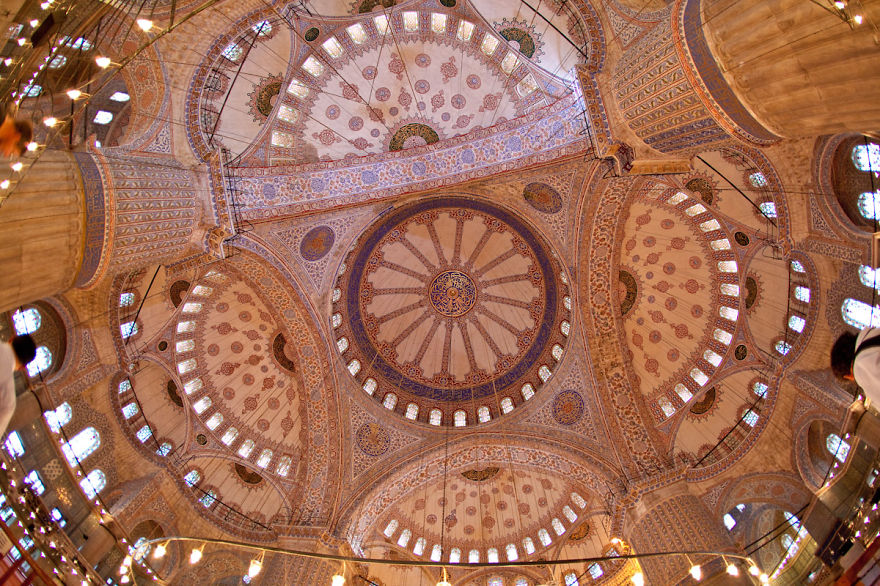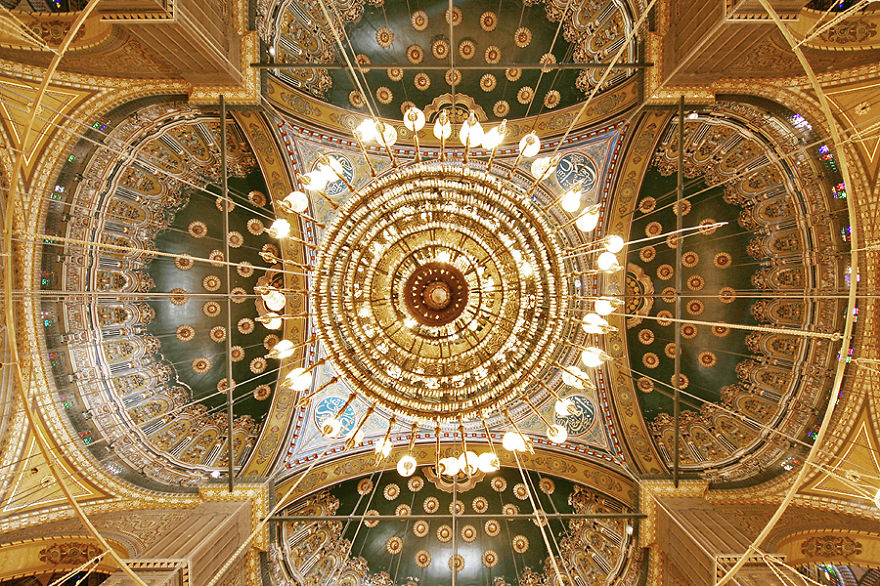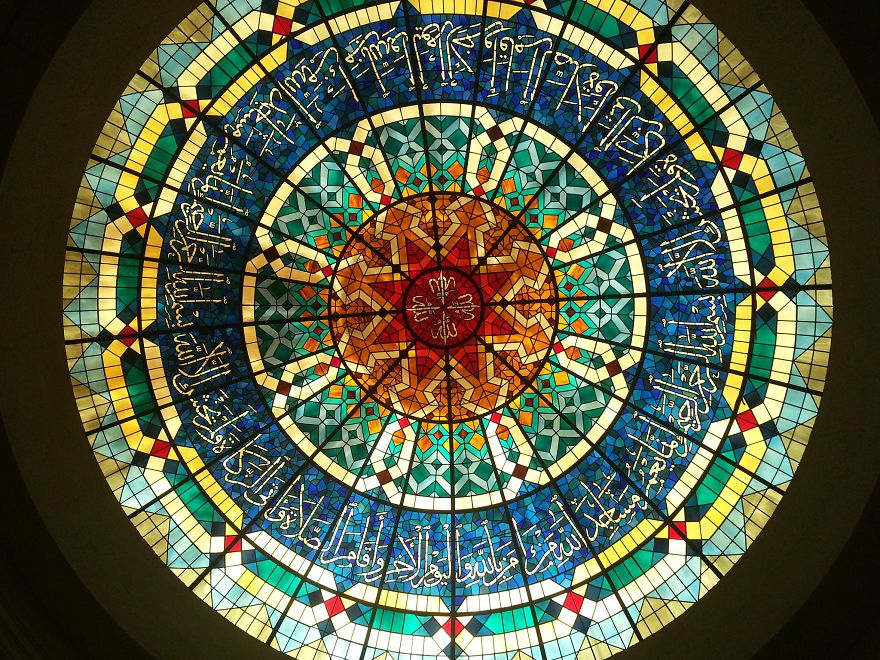

Stunning Ceilings from the Wonders of Islamic Architecture
by Cem NizamogluPublished on: 5th December 2019
Discover ceilings from buildings inspired by Islamic architecture where looking up is a spellbinding experience! Each has a design and a story of its own. Most of them are distinctive and unique in respect of their architecture and hold outstanding features.

***
Note of the Editor: This article was first composed by Cem Nizamoglu for 1001 Inventions website and now updated for Muslim Heritage website.
***
“Keep looking up… that’s the secret of life.” Snoopy
Islamic architecture encompasses a wide range of both secular and religious styles from the early period of Islam to the present day, influencing the design and construction of buildings and structures in Islamic culture and beyond. The principal Islamic architectural types are the Mosque, the Tomb, the Palace, the Fort, the School, and urban buildings. For all these types of constructions, Islamic architecture developed a rich vocabulary that was also used for buildings of lesser importance such as public baths, fountains and domestic architecture.(*)
These numerous structures: mosques, palaces, mausoleums and shrines all around the world have breathtaking ceilings. Each has a design and a story of its own. Most of them are distinctive and unique in respect to their architecture and they all hold outstanding features. Thus it will not be fair to come up with a list of examples. However, to introduce some of these marvellous monuments, we have chosen ceilings that we found spellbinding. We have arranged them in alphabetical order according to the modern-day country they reside in:
Discover ceilings from buildings inspired by Islamic architecture where looking up is a spellbinding experience! Each has a design and a story of its own. Most of them are distinctive and unique for their architecture and hold outstanding features:
***
Egypt: Masjid al-Sultan Barquq, Cairo

(Photo by Abdelrahman Assem)
On the internet, it is mostly shared as Al Soltan Qalawoon Mosque(*) but some Egyptians claim this is Sultan Barquq Mosque and Madrasa (*).
Opened in 1386. Architect’s name is Shihab al-Din Ahmad ibn Muhammad al Tuluni. The architectural style is Bahri Mamluk. The Madrasa-Khanqah of Sultan Barquq lies in El Muiz Li Din Allah Street next to the Mosque and Madrasa of Kamil Ayyub and the Madrasa of El Nasir. This complex was consisting of a Khanqah or hospice for the Sufi students, a Madrasa or a school that was a place for worship and study of Quran and prophetic instructions, and a mausoleum standing in one of the corners of the Madrasa. It was established by Sultan Barquq who was the first Bahri Mamluk to ascend the throne of Egypt in 1382 and the husband of the widow of Sultan Shaban. The historians expound that he managed to assume power after killing many people and plotting against others. After holding power he worked hard to defend his throne and protect it from the plots of the Syrian Mamluk Emirs. (*)
Read More: archnet.org/sites/2217
***
India: The Taj Mahal, Agra
Opened in 1648, Architects’ names are Ustad Ahmad Lahouri and Ustad Isa. Architectural styles are Mughal Persian. The Taj Mahal is a white marble mausoleum located on the southern bank of the Yamuna River in the Indian city of Agra. It was commissioned in 1632 by the Mughal emperor Shah Jahan to house the tomb of his favorite wife of three, Mumtaz Mahal.(*)
Homepage: tajmahal.gov.in
***
Iran: Sheikh Lotfollah Mosque, Isfahan
Opened in1619. Architects’ names are Bahāʾ al-dīn al-ʿĀmilī and Ustad Mohammad Reza Isfahani. The architectural style is Isfahani. Sheikh Lotfollah Mosque is one of the architectural masterpieces of Safavid Iranian architecture, standing on the eastern side of Naghsh-i Jahan Square, Isfahan, Iran. Construction of the mosque started in 1603 and was finished in 1619. It was built by the chief architect Shaykh Bahai, during the reign of Shah Abbas I of the Safavid dynasty. (*)
Read More: Stanford.edu – Sheikh-Lotfallah-Mosque.pdf
Also see the story about Nasir al-Mulk Mosque in Shiraz, Iran
Also see the story about Nasir al-Mulk Mosque in Shiraz, Iran
***
Iraq: Jalil Khayat Mosque, Erbil (Arbil)
Opened in 2007. Built by Jalil Hayat. Architectural styles are Egyptian and Ottoman. Jalil Khayat mosque, which resembles in style the Muhammad Ali mosque in Cairo and the Blue Mosque in Istanbul, was inaugurated in Erbil on January 19, 2007, after being under construction for many years. Jalil Khayat, one of the better-known, wealthier people in Erbil, had the mosque built. His sons proudly took over the project after Khayat passed away in 2005. Haji Dara, one of Khayat’s sons, expressed happiness that they could complete this “charity project” and witness the first Mawlood in their new mosque.
Read More: beautifulmosque.com
***
Jordan: Jabal al-Qal’a (Amman Citadel), Amman

(Photo by Erik Coenjaerts)
The Hill of the Citadel (Jabal al-Qal’a) in the middle of Amman was occupied as early as the Neolithic period, and fortified during the Bronze Age (1800 BC). The ruins on the hill today are Roman through early Islamic. The name “Amman” comes from “Rabbath Ammon,” or “Great City of the Ammonites,” who settled in the region sometime after 1200 BC. The Bible records that King David captured the city in the early 10th century BC; Uriah the Hittite, husband of King David’s paramour Bathsheba, was killed here after the king ordered him to the front line of battle.
In ancient times, Amman with its surrounding region was successively ruled by the then-superpowers of the Middle East: Assyria (8th century BC), Babylonia (6th century), the Ptolemies, the Seleucids (third century BC), Rome (1st century BC), and the Umayyads (7th century AD). Renamed “Philadelphia” after himself by Ptolemy II Philadelphus, the city was incorporated into Pompey the Great’s province of Syria, and later into the province of Arabia created by Trajan (106 AD). As the southernmost city of the Decapolis, Philadelphia prospered during Imperial times due to its advantageous location alongside Trajan’s new trade and administrative road, the Via Nova Traiana.
When Transjordan passed into Arab rule in the 7th century AD, its Umayyad rulers restored the city’s original name of Amman. Neglected under the Abbasids and abandoned by the Mamlukes, the city’s fortunes did not revive until the late 19th century, under the Ottoman empire. Amman became the capital of the Emirate of Transjordan in 1921, and the newly-created Hashemite Kingdom of Jordan in 1947. Greater Amman (the core city plus suburbs) today remains by far the most important urban area in Jordan, containing over half of the country’s population of about 3 million out of 5 million people.
Text Source: www.art-and-archaeology.com
***
Morocco: Hassan II Mosque, Casablanca
 (Photo – possibly – by Souad El-Ouafi)
(Photo – possibly – by Souad El-Ouafi)Opened in 1993, the historical context of the mosque began with the death of King Mohammed V in 1961. King Hassan II had requested for the best of the country’s artisans to come forward and submit plans for a mausoleum to honor the departed king; it should “reflect the fervor and veneration with which this illustrious man was regarded.” In 1980, during his birthday celebrations, Hassan II had made his ambitions very clear for creating a single landmark monument in Casablanca by stating:
“I wish Casablanca to be endowed with a large, fine building of which it can be proud until the end of time … I want to build this mosque on the water, because God’s throne is on the water. Therefore, the faithful who go there to pray, to praise the creator on firm soil, can contemplate God’s sky and ocean.”
The building was commissioned by King Hassan II to be the most ambitious structure ever built in Morocco. It was designed by the French architect Michel Pinseau who had lived in Morocco and was constructed by the civil engineering group Bouygues.
Work commenced on July 12, 1986, and was conducted over seven years. Construction was scheduled to be completed in 1989 ready for Hassan II’s 60th birthday. During the most intense period of construction, 1400 men worked during the day and another 1100 during the night. 10,000 artists and craftsmen participated in building and beautifying the mosque.[2] However, the building was not completed on schedule which delayed inauguration. The formal inauguration was subsequently chosen to be the 11th Rabi’ al-Awwal of the year 1414 of the Hijra, corresponding to 30 August 1993, which also marked the eve of the anniversary of Prophet Muhammad’s birth. It was dedicated to the Sovereign of Morocco.(*)
Homepage: fmh2.ma/en
***
Oman: Sultan Qaboos Grand Mosque, Muskat, Matrah
 (Photo by Werner_B)
(Photo by Werner_B)Opened 2011, Qaboos bin Said al Said, Sultan of Oman, directed that his country should have a Grand Mosque in 1992. A competition for its design took place in 1993 and after a site was chosen at Bausher construction commenced in December 1994. Building work, which was undertaken by Carillion Alawi LLC, took six years and seven months.(*)
Close to the road leading to the heart of the capital Muscat stands the Sultan Qaboos Grand Mosque in Wilayat (district) Bawshar, like a radiant lighthouse attracting its visitors to interact with the spirit of Islam as a religion, science, and civilisation. This mosque highlights its role as a scientific and intellectual source of knowledge across the Islamic world… The dome is made up of spherical triangles within a structure of sides and marble columns, crossed with pointed arches and decorated with porcelain panels. Timber panels stretch in a fashion that reflects the architectural development of Omani ceilings.(*)
Homepage: sultanqaboosgrandmosque.com
***
Pakistan: Wazir Khan Mosque, Lahore

(Photo by Salman Arif)
Opened in 1642. Restored by Muhammad Wali Ullah Khan. Architectural styles are Indo-Islamic and Mughal. The Wazir Khan Mosque in Lahore, Pakistan, is famous for its extensive faience tile work. It has been described as ‘a mole on the cheek of Lahore’. The mosque was built during the reign of Mughal Emperor Shah Jahan. The construction started in 1634 and lasted for 7 years. The mosque was named after Hakim Shaikh Ilm-ud-din Ansari, widely known as Wazir (translated from Farsi – minister) Khan, who was the governor of Lahore and the initiator of the mosque’s construction. (*)
Read More: lahoretourism.net
***
Palestine: Dome of the Rock, Jerusalem

Opened in 691. Architects’ names are Raja ibn Haywah and Yazid Ibn Salam. Architectural styles are Islamic and Byzantine. The Dome of the Rock (Arabic: قبة الصخرة, translit.: Qubbat Al-Sakhrah, Hebrew: כיפת הסלע, translit.: Kipat Hasela) is a shrine located on the Temple Mount in the Old City of Jerusalem. It was initially completed in 691 CE at the order of Umayyad Caliph Abd al-Malik during the Second Fitna. The Dome of the Rock is now one of the oldest works of Islamic architecture. It has been called “Jerusalem’s most recognizable landmark”. Its architecture and mosaics were patterned after nearby Byzantine churches and palaces. The octagonal plan of the structure may also have been influenced by the Byzantine Chapel of St Mary (also known as Kathisma and al-Qadismu) built between 451 and 458 on the road between Jerusalem and Bethlehem. The site’s significance stems from religious traditions regarding the rock, known as the Foundation Stone, at its heart, which bears great significance for Jews and Muslims.(*)
Homepage: domeoftherock.net
***
Spain: Alhambra Palace, Granada

The above photo shows the Honey Comb Dome in Hall of the Abencerages. One cannot discuss Muslim Spain without referring to the famous Al-Hambra Palace in Granada. Its origins are still under debate as most scholars dated it to 13th century Granada, but some indications suggest it was first built in the 11th century – a significant time for both Muslim and European architecture. (Also “the first historical documents known about the Alhambra date from the 9th century and they refer to Sawwar ben Hamdun who, in the year 889, had to seek refuge in the Alcazaba, a fortress, and had to repair it due to the civil rights that were destroying the Caliphate of Cordoba, to which Granada then belonged…”*). The palace complex briefly consists of a series of apartments, halls, and courts organised in a delightful interconnected setting of hierarchy. The palace is an architectural masterpiece in every term. The successions of spaces are clearly defined by boundaries and each space contains identical features enhancing its identity as well as its function.
Read More: muslimheritage.com
***
Turkey: Selimiye Mosque, Edirne
 (Photo by sugraphic.com)
(Photo by sugraphic.com)Opened in 1574. The architect’s name was was Mimar Sinan. Architectural styles are Islamic and Byzantine. The Selimiye Mosque is an Ottoman imperial mosque, which is located in the city of Edirne, Turkey. The mosque was commissioned by Sultan Selim II and was built by architect Mimar Sinan between 1569 and 1575. The interior of the mosque received great recognitions from its clean, spare lines in the structure itself. With the monumental exteriors proclaiming the wealth and power of the Ottoman Empire, the plain symmetrical interiors reminded the sultans should always provide a humble and faithful heart to connect and communicate with God. To enter, it was to forget the power, determination, wealth and technical mastery of the Ottoman Empire. Lights have seeped through a multitude of tiny windows, and the interchanging of the weak light and dark was interpreted as the insignificance of humans. The Selimiye did not only amaze the public with the extravagant symmetrical exterior, but it had also astonished the people with the plain symmetrical interior for it had summarized all Ottoman architectural thinking in one simple pure form. (*)
Homepage: selimiyemosque.org
***
UAE: Sheikh Zayed Grand Mosque, Abu Dhabi
Opened in 2007, Architect’s name is Yusef Abdelki. The architectural style is both Mughal and Moorish. Sheikh Zayed Grand Mosque is located in Abu Dhabi, the capital city of the United Arab Emirates and is considered to be one of the key mosques for worship in the country but is also the number one mosque destination for tourists to the country. It boasts Mughal and Moorish architectural styles.
Homepage: szgmc.ae/en
***
Uzbekistan: Bahaud-Din Naqshband Mausoleum, Bukhara
Opened in 1544. Built by Khan Abd al-Aziz. Architectural styles are Islamic and Ottoman. “Baha-ud-Din Naqshband Bukhari (1318–1389) was the founder of what would become one of the largest and most influential Sufi Muslim orders, the Naqshbandi.”(*) “Memorial complex of Bahauddin Naqshbandi is located 12 kilometers from Bukhara. Once it was the place of settlement of Kasri Arifon, which was famous for its pagan customs and holidays.”(*) Memorial complex Bahauddin Naqshbandi is a rectangular courtyard where the tomb of Sheikh Bukhari. The modern aivan with wooden columns is decored the central courtyard and near built the great building Khanaka. Later here was formed a vast necropolis – the tomb of Bukhara emirs. Decorated mosques Muzaffarkhan and Hakim Kushbegi are struck by its beauty, which formed the courtyard with a creek around the mausoleum. At the beginning of our century, the Memorial complex Bahauddin Naqshbandi was restored. The arches in national style, blue domes, different gates, and columns were built here. One of the most beautiful of the architectural ensemble of Bukhara, the complex Bahauddin Naqshbandi meets pilgrims with silence and solitude…(*)
Read More: sufiwiki.com
***
- Samarqand UZ – Registan Ulugbek-Madrasa 03 by Daniel Mennerich (flickr.com)
- Nasir Al-Mulk Mosque, Shiraz, Iran (Photo by Mohammad Reza Domiri Ganji)
- Fatima Masumeh Shrine, Qom, Iran (Photo from imgur.com)
- Badshahi Mosque, Lahore, Pakistan (Photo from www.friendskorner.com)
- Real Alcázar, Sevilla, Spain
- Sheikh Zayed Mosque, Abu Dhabi, Uae
- Bajram Pasha Isa Beg Mosque, Mitrovice, Kosove
- Royal Graves At Cairo , Egypt
- Al Saleh Mosque – Sana’a – Yemen
- Suleymaniye, Istanbul, Turkey
- Shah Jahan Mosque, Thatha, Pakistan. (Photo from www.flickr.com)
- Cairo, Egypt (Photo by Faisal Almalki)
- Ruhobod Mosque, Samarkand (Photo by Komila Rakhimova)
- Temur’s Mausoleum In Samarkand, Uzbekistan
- Blue Mosque, Turkey
- Registan, Uzbekistan (Photo from shanghaiamsterdam.com)
- Mihrab Dome, Mezquita, Cordoba, Spain (Photo by Aidan McRae Thomson)
- Ali Ibn (ebne) Hazem Holly Shrine. Shiraz, Iran
- Grand Mosque of Isfahan, Isfahan, Iran (Photo by Ali Kordzadeh)
- Fatima Masumeh Shrine, Qom, Iran (from imgur.com)
- The Whittier Mosque Ceiling (scalar.usc.edu)
- Ceiling of Main Hall- Badshahi Mosque, Pakistan. Photo by Ahmed saad (Wikipedia)
- Tillakari madrassa mosque ceiling, Samarkand, Uzbekistan (eastwestquest.com)
- Interior of a mosque in Belgium. A monumental chandelier hangs from the center of the ceiling. Photo by Manitoba (shutterstock.com)
- Bahrain Mosque by Mustafa Bastaki (500px)
- The main entrance of The Al-Fateh Mosque in Bahrain. Photo by Ahmed Sadoon (Wikipedia)
- Main Prayer Hall of Al-Fateh Grand Mosque in Bahrain Photo by Ahmed Sadoon (Wikipedia)
- Nasir Al-Mulk Mosque, Shiraz, Iran (Photo by Ramin Rahmani Nejad)
- Niksar Yagibasan Medresesi Foto by Alpaslan ALTINTAS
- Yıldız Hαmidiye Cαmii, Turkey by gLy SuNfLoWeR (flickr.com)

























































No hay comentarios:
Publicar un comentario